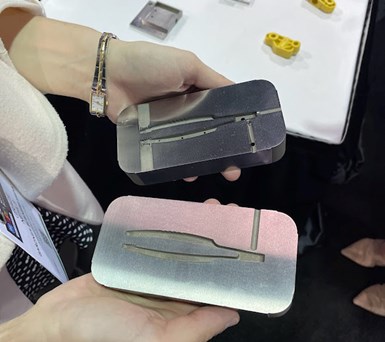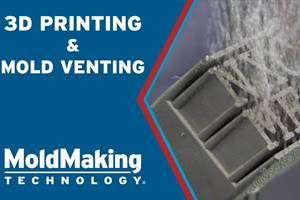Taking the Plunge: AM Resources for Mold Builders
Additive manufacturing is a trending manufacturing process for a range of industries, least of all moldmaking, and its implementation has demonstrated a host of benefits.

At PTXPO in March 2022, Westminster displayed its exploration in metal additive, represented by these metal 3D-printed cavities for medical devices. Photo Credit: MMT
The world of additive manufacturing/AM (also known as 3D printing) has become a burgeoning market the last few years and is still growing exponentially. According to Wohler’s Report 2022, research showed 19.5% in industry growth in 2021, a significant 12% increase from the previous year. The technology has also become increasingly important within the realm of moldmaking. But why use AM to produce 3D-printed molds and tools? And how can it change your business?
Making 3D Printing a Reality in Your Shop
Producing specialized tools and parts is considered to be one of the most resource-intensive manufacturing processes. Moreover, conventional processes like injection molding tend to be expensive, time-consuming and challenging, particularly when producing complex molds.
Working in tandem with the technological advances of 3D printing, however, it is possible to address a wide range of moldmaking needs from printing entire molds or inserts, to localized repair or hardface welding of mold surfaces and adding conformal cooling to a mold’s difficult-to-cool areas (which has demonstrated a reduction in cycle times by as much as 15-30%). This is in addition to enhancing application variety and design freedom, while maintaining part quality and high productivity rates. AM can also incorporate a growing catalog of materials including metal alloys, thermoplastics, thermoset polymers and composites.
“[Ultimately] it contributes to an injection molder’s profitability through high-margin bridge molding, part count reduction, quick-to-market commercialization and the manufacturing of very complex, expensive parts,” David Pierick, 3D printing application development manager at HP Inc., notes in “What Is Additive Manufacturing's Place Alongside Traditional Moldmaking?”
Moldmakers can even adopt AM through hybrid manufacturing, which involves a traditionally manufactured mold in which AM is used to add new features, or even build up worn areas. Cost savings are often associated with reducing machining waste/scrap.
AM Resources for Mold Builders
AM is certainly not perfect. However, it has arguably become the broadest category in manufacturing, supported by a variety of software, hardware and material capabilities.
The first step toward adoption is becoming familiar with the topic. MoldMaking Technology has a zone page dedicated to Additive Manufacturing, where those interested can explore various products, news and articles related to the subject in the moldmaking industry (more specifics below). For a broader approach to the technology, you can also visit sister publication, Additive Manufacturing’s “New to AM” section.
MMT has also released its July 2022 Sourcing and Technology Guide, which has its own section designated to AM, including 40 key suppliers, technologies and services offered and a Tip of the Month article, all of which can be found under the “Magazine” tab on the website homepage.
Related Content
Products and Services for Multiple Moldmaking Needs
New year, new technology roundup! Featured here is a collection of product offerings, from profile milling cutters to industry-specific CAD/CAM software to innovative hot work tool steels.
Read MoreLarge Hybrid Steel Insert Solves Deformation, Dimensionality, Cycle Time Problems
DMLS printers using metal additive powders selected by Linear AMS to produce high-quality, accurate, consistent 3D-printed mold components with certification and traceability.
Read MoreAdvancing the Mold With New Technologies
This roundup is full of products and services that help answer concerns and meet needs for the industry. Featured in this roundup are hot runners, mold components, mold materials and more.
Read MoreVIDEO: How can 3D Printed Tooling Improve Injection Mold Venting?
Proper venting is one of a mold builders toughest challenges as molders struggle to keep vents free flowing in production. Learn how to apply 3D printing to mold venting and the benefits of additive venting inserts.
Read MoreRead Next
Reasons to Use Fiber Lasers for Mold Cleaning
Fiber lasers offer a simplicity, speed, control and portability, minimizing mold cleaning risks.
Read MoreAre You a Moldmaker Considering 3D Printing? Consider the 3D Printing Workshop at NPE2024
Presentations will cover 3D printing for mold tooling, material innovation, product development, bridge production and full-scale, high-volume additive manufacturing.
Read MoreHow to Use Strategic Planning Tools, Data to Manage the Human Side of Business
Q&A with Marion Wells, MMT EAB member and founder of Human Asset Management.
Read More












_300x250 3.png;maxWidth=300;quality=90)


.jpg;maxWidth=300;quality=90)










